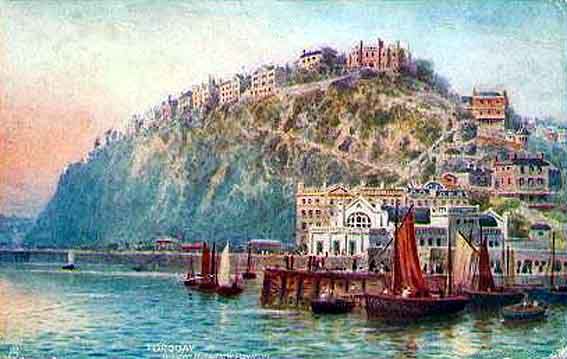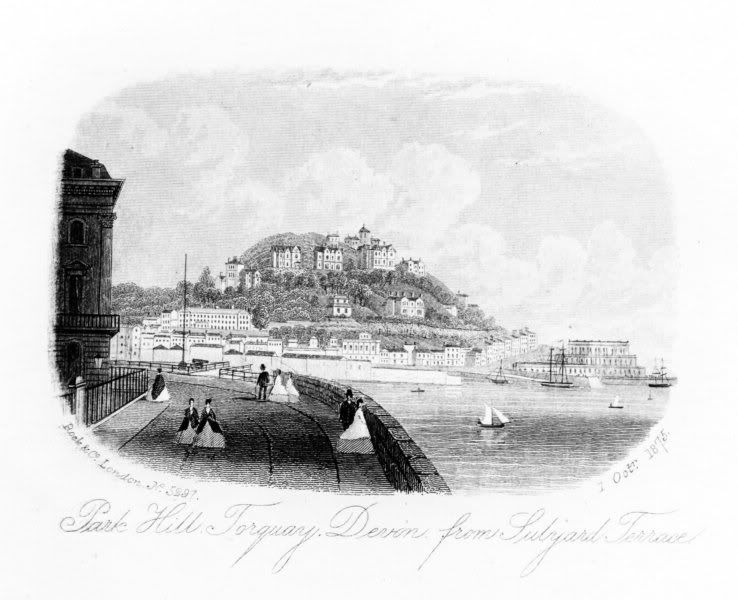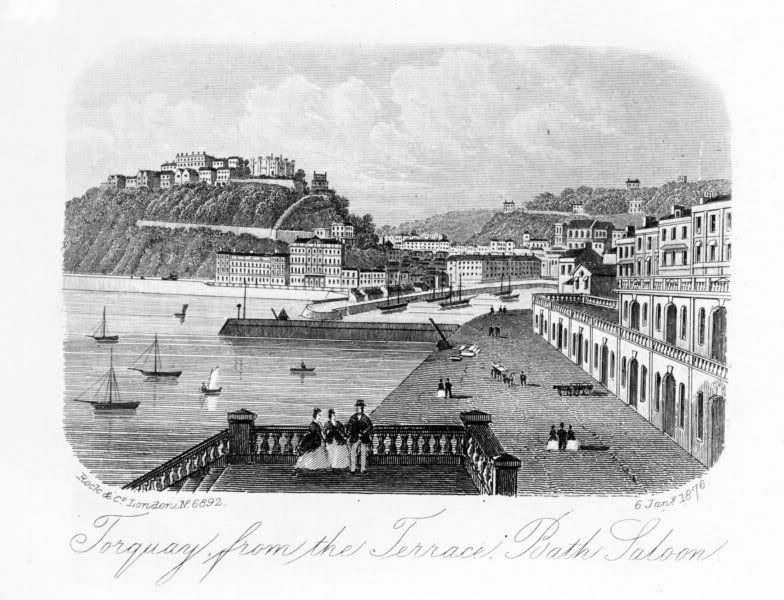Dave
TFF member

Posts: 13,081
|
Post by Dave on Dec 14, 2008 19:23:31 GMT
I have found an account of the day the church was bombed, written by someone who was inside at the time.
It was 2.40 p.m. on Sunday May 30 1943 when tragedy struck. I know the exact time because the clock on the tower stopped.
My brother and I were at Sunday School in the Church Hall; our sister, being older, was in the church. The siren sounded; we younger ones were led into a passage by the side of the stage; our sister, with several others, hid under a pew at the back of the church. Suddenly there was a quick succession of explosions. The fire exit doors in the passage blew inwards, a gaping hole appeared in front of the stage, the porch at the end of the hall had disappeared. When we clambered over the rubble, we found the church, apart from the tower, had gone. My brother and I ran home to tell our parents. We rushed back to learn that our sister had survived, and after some time discovered she had been taken to a nursing home for treatment to a leg injury. She was one of the lucky few. Twenty-nine children and three adult teachers perished that afternoon: they had all been in the front of the church.
The victims were buried in a mass grave, near to where the German pilot was interred. Controversy raged over this decision, but anger and anguish relented somewhat when witnesses recounted the pilot’s vain efforts to avert the tragedy. His plane had been crippled by anti-aircraft fire. He had turned inland, clipped the spire of the neighbouring Roman Catholic Church, and realised he was rapidly losing height. He decided to jettison his bomb, hoping it would fall into the churchyard, and not onto a highly populated residential area. Tragically it missed by about forty feet. The plane staggered over the church and plunged into the ground at the bottom of the hill a quarter of a mile away.
|
|
Deleted
Deleted Member
Posts: 0
|
Post by Deleted on Dec 14, 2008 19:36:25 GMT
Yes, a very different churchyard scene at St Marychurch. As for the Princess Gardens, the 1890s were a busy time for laying out municipal parks. Taunton's Vivary Park dates from the same time and both have very similar fountains made by Walter MacFarlane & Company at the Saracen foundry in Glasgow. I can remember the Princess Theatre being built. It's sign of age when buildings you regard as "new" are now pretty "old" - especially when some you see being demolished you remember being built! In the 1960s I went behind the scenes at both the Princess and the Festival Theatre in Paignton because my parents were friendly with the comedian Billy Dainty from his days of appearing at the Babbacombe Theatre. No pictures of Billy but how about this one of Max and friends?  And here's Frankie opening the new Co-op:  These pictures thanks to good old John Pike. |
|
merse
TFF member

Posts: 2,684
|
Post by merse on Dec 14, 2008 19:49:42 GMT
 I thought Frankie Vaughan was a sex symbol and pin up guy? It seems like old Max got the better deal in women and poor Frankie couldn't wait to open another bloody CO-OP!  Gimme da moonlight Gimme da moonlight................... 
|
|
bbcgull
Programmes Room Manager 
Posts: 1,346
|
Post by bbcgull on Dec 14, 2008 21:35:37 GMT
My Grandad Fred 'Murky' Meyer was one of the people who helped rebuild it after it was bombed.
|
|
Dave
TFF member

Posts: 13,081
|
Post by Dave on Dec 16, 2008 18:43:05 GMT
My Grandad Fred 'Murky' Meyer was one of the people who helped rebuild it after it was bombed. I was once a part of this church, I must confess that I'm not religious in any way, but my ex wife was. Not only did I get married to her in the church, but I was confined at the age of 24 years old and my three children were all christened and confirmed there also. I was in the choir for some time and that I really did enjoy, I love the evening service the best as the singing was more in the form of chants and had such an old feel about it all. I did no like the dressing up in my red dress and white top thing, that were the same as in the picture below. The church is a High Church and some say such C.of E Church's are more Catholic than the catholic church itself. I also ran the cub group at the church, I did find it to be a very clicky place and not the close knit group you might expect.  |
|
Deleted
Deleted Member
Posts: 0
|
Post by Deleted on Dec 16, 2008 22:53:40 GMT
It's astonishing how you can see the two churches at St Marychurch from so many places in South Devon including Dartmoor. Denbury hill fort and the transmitters at Beacon Hill are other landmarks I notice from all manner of places.
When Sean O'Casey, the Irish playwright, saw out his final years in the 1960s living in Trumlands Road it was said that the view from his flat - of both the Anglican and Catholic churches at St Marychurch - was almost identical to what he saw from his home in St Barnabas, Dublin.
|
|
Deleted
Deleted Member
Posts: 0
|
Post by Deleted on Dec 18, 2008 19:19:22 GMT
Continuing the aerial theme here's some detail from an air navigation chart I found in Standford's in Bristol:  And here's a poster advertising services to/from Torquay Airport - or Channings Wood, Denbury to be more precise - opened in 1935:  From Mike Holgate's Images of England - Torquay. |
|
Dave
TFF member

Posts: 13,081
|
Post by Dave on Dec 18, 2008 19:26:50 GMT
Seems a bit of a con Barton, if you ask me ;)How can you say fly to Torquay, when the plane only go's to Denbury? It must have taken nearly as long to then get to Torquay by bus, than it would have to travel from Exeter airport.
Having gone to Channing Wood with Ant(when he played football there) I do wonder where any runway would have fitted, a good find anyway and one I hope you can supply more detail on.
|
|
Deleted
Deleted Member
Posts: 0
|
Post by Deleted on Dec 18, 2008 20:11:25 GMT
It was only an airfield for a short while and was soon lost with the building of Denbury military camp in 1939. Apparently Denbury was mainly used as a "stop over" for refuelling. Doesn't look too grand by the look of these pictures found at www.btinternet.com/~denbury/airfield.html  There is a fuller account - together with several pictures - at www.devonstrut.co.uk/pages/newarticles/NL0606%20for%20web.pdf (the newsletter of the Popular Flying Association - see pages 2/3) This article mentions an original plan to build an airfield at Drumbridges as an alternative to the existing faciliity at Haldon which suffered from bad weather. This proposal was overtaken by the creation of Denbury which witnessed a gala opening in 1935. Two airlines - Provincial and Railway Air Services - used Denbury and Jack Payne, the bandleader, flew in to fulfil an engagement in Torquay. It sounds as if the airfield didn't last into 1936 and it soon reverted to grazing land until the building of the camp. Haldon was in use from 1928 with commercial flights starting in 1933 and continuing until the opening of Denbury. Then, in 1937, commercial activity switched to the new Exeter airport. Haldon was requisitioned for military purposes and the site is now part of Teignmouth golf course. |
|
Deleted
Deleted Member
Posts: 0
|
Post by Deleted on Dec 21, 2008 0:05:54 GMT
Princess Gardens - and one of Walter MacFarlane's fountains - in full glory:  |
|
Dave
TFF member

Posts: 13,081
|
Post by Dave on Dec 24, 2009 15:15:57 GMT
 With respect the land claimed in Victorian times (it was never there previously to be re-claimed) was the piece where the road runs beneath the cliffs and the gardens with the war memorial and Regency style fountain in them. Am I mistaken in calling those Princess Gardens? If so, are they Pavilion Gardens or something else? Prior to that the only road was up and over the rock face where those hotels stand. I distinctly remember the major engineering project when I was a young boy of the "rafts" being extended out into the sea to provide support for that curved double decked promenade and the Princess Theatre being built at the same time. the bit where there is another fountain in a more sixties style. The bit that is reported to be "subsiding" is the Victorian project as you say. I recently found these photos, the first shows just the road under Rock Walk before the Victorians reclaimed the land from the sea to build the gardens       |
|
merse
TFF member

Posts: 2,684
|
Post by merse on Dec 24, 2009 16:32:52 GMT
 With respect the land claimed in Victorian times (it was never there previously to be re-claimed) was the piece where the road runs beneath the cliffs and the gardens with the war memorial and Regency style fountain in them. Am I mistaken in calling those Princess Gardens? If so, are they Pavilion Gardens or something else? Prior to that the only road was up and over the rock face where those hotels stand. I distinctly remember the major engineering project when I was a young boy of the "rafts" being extended out into the sea to provide support for that curved double decked promenade and the Princess Theatre being built at the same time. the bit where there is another fountain in a more sixties style. The bit that is reported to be "subsiding" is the Victorian project as you say. I recently found these photos, the first shows just the road under Rock Walk before the Victorians reclaimed the land form the sea th build the gardens   Nice to be proven correct even after a whole year.............thanks Dave! Note too how even The Pavilion had yet to be built at the time of this picture. |
|
|
|
Post by kennjay on Mar 21, 2014 11:05:20 GMT
Hi I came across your post whilst searching for information on air raids on Toquay in WW2. The reconnaissance photo is amazing and so clear I can see Perinville Road, Babbacobe, and the house where I was born and lived in through the war. I winessed most of the raids and I am pretty sure I witnessed the bomb leaving the low flying plane that landed on the church in St Mary's. I was standing outside the house and the blast pushed me backwards into the porch.
The other posting from the witness of that bomb raid tells a different story about the church spire, to the one I was told by my mother. The plane that hit the spire lost control tuned left and losing height to avoid falling onto a built up area crashed onto Tor Abbey Sands just in front of the sea wall and short of Princess Pier. I saw the plane later at low tide stood on its nose but not seriosly damaged. I don't know whether the pilot survived or not.
Would you know if the Herald Express has a decent and accesable archive of reports and photos of these raids. I would really like to research this part of Torquays history and perhaps add my own very vivid recollections. I was aged 8/9 and was in or near our house during four daylight raids low flying fighter/bombers and one night raid by Stuka bombers. All bombs from the latter landed in sea in Babbacombe Bay and resulted in the water in front of Oddicombe Beach being covered with dead fish.
I used to go and watch United play at Plainmoor as a boy, and saw Moscow Dynamo play there after the war!
I don't know if its possible for you to scan and email me a copy of the aerial photo, I would like to print and frame it.
Kennjay
|
|
Deleted
Deleted Member
Posts: 0
|
Post by Deleted on Mar 21, 2014 20:01:52 GMT
Hello Kennjay, yes I can certainly send you a scan of the picture. I've sent you a message through this site's internal messaging system (go to "messages" on the toolbar at the head of the page). Just let me have your email address by replying to the message. Thanks for showing an interest in some of the posts on the site. We were probably most active with local history discussion about four or five years ago!
|
|
Jon
Admin 
Posts: 6,912
|
Post by Jon on Mar 22, 2014 8:38:04 GMT
Would you know if the Herald Express has a decent and accesable archive of reports and photos of these raids. I would really like to research this part of Torquays history and perhaps add my own very vivid recollections. Welcome to the forum! Historian MIKE HOLGATE is co-ordinating a project to record life in Torquay during WW2 in as much detail as possible. He works in the reference section at Torquay Library. If you are still based in South Devon, I would recommend you to contact the library to see if you can talk to Mike. |
|



 I thought Frankie Vaughan was a sex symbol and pin up guy?
I thought Frankie Vaughan was a sex symbol and pin up guy?












 Nice to be proven correct even after a whole year.............thanks Dave!
Nice to be proven correct even after a whole year.............thanks Dave!